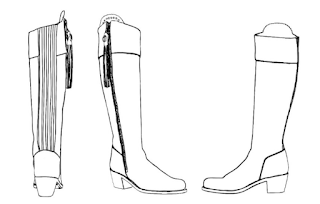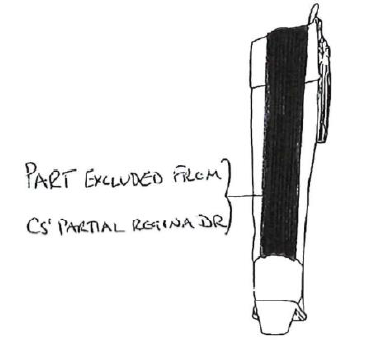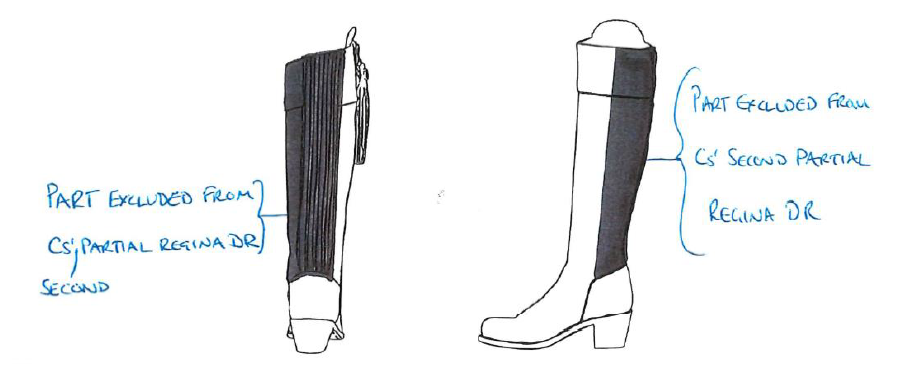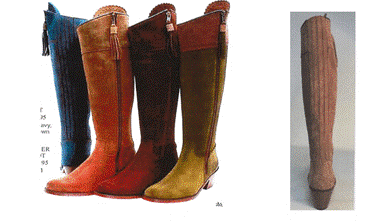Spanish-style riding boots stepped into the Intellectual Property Enterprise Court this spring in an infringement trial between Fairfax & Favor Limited (“F&F”) and the House of Bruar Limited ("HoB"). Demonstrating the power of IP in the fashion industry, this case highlights the importance of a well-designed IP strategy, and how automatically arising unregistered design rights can save the day when a registered design right might be easily circumventable.
One of these days these boots are gonna walk all over you…
F&F sell luxury leather goods online which have a country look about them – but importantly to their overall impression, their products aren’t designed practically as serious utilitarian country wear.
Based on a traditional Spanish-style riding boot, F&F’s Heeled Regina has a full length zip with a tassel pull and fan, and a rear elasticated gusset panel covered with four strips. An EU design application (subsequently cloned as a UK registered design) was filed for the Heeled Regina in January 2016.
F&F’s Heeled Regina; source: https://www.fairfaxandfavor.com/products/the-heeled-regina-tan-suede-boot?gclid=CjwKCAjwzeqVBhAoEiwAOrEmzaQrpm6RpaV4Xs6GQkGJQOs1Mdm2fli2R-QuLx_uQ3m3AwJQYRDVwBoC_rkQAvD_BwE
The registered design application’s images showed the three key features of the boot: the fan, tassel, and gusset.
 |
F&F’s registered design; source: https://www.bailii.org/ew/cases/EWHC/IPEC/2022/689.html
At trial, F&F also asserted UK unregistered design right for three designs: (i) the whole boot (essentially the same claim as the registered design); (ii) the boot with the back elasticated panel excluded (see below, left); and (iii) the boot with the back elasticated panel and part of the inner side of the boot excluded (see below, centre and right) – i.e. the full boot design and two partial designs.
Unregistered design right arises automatically in the UK and the EU upon creation of a design – e.g. upon a designer first sketching out a concept. Recording drawings for unregistered design right of partial designs (rather than just the overall boot) may thus seem unusual – akin to disclaiming features in a registered design – but this forward thinking approach proved fruitful to F&F at trial.
 |
 |
F&F’s unregistered design drawings for partial designs; source: https://www.bailii.org/ew/cases/EWHC/IPEC/2022/689.html
Starting off on the wrong foot
Country clothing retailer HoB had previously admitted infringement of another of F&F’s designs in their defence and counterclaim for this case, so F&F asserted that HoB had a propensity to copy their designs.
After initial discussions between HoB and F&F resulted in no agreement or sales from F&F to HoB, HoB ladieswear buyer Mrs Meikle purchased a pair of Heeled Reginas for personal use. A month later, another HoB employee ordered a pair on his company credit card on next day delivery to a HoB designer – seemingly not for personal use.
Mrs Meikle later decided not to sell F&F’s boots at HoB and ordered samples and stock of a boot referred to as the “version 1 boot” from a company called Dakota Boots for inclusion in HoB’s catalogue. F&F alleged that this boot included all the elements of the Heeled Regina, and when Dakota Boots failed to deliver, F&F reached out to offer to supply HoB. HoB refused the offer.
Adding to this history, a later photoshoot for HoB’s catalogue included boots F&F alleged were theirs, alongside a copycat Heeled Regina. Undergoing supply issues, HoB then tried to order stock from F&F, who refused after being tipped off about their boots being used in HoB’s catalogue.
HoB then designed a “version 2 boot” in the hope of resolving a complaint raised by F&F, which had two rather than four strips over the gusset, no piping at the top, and a different coloured lining.
 |
HoB’s version 1 and 2 boots; source: https://www.bailii.org/ew/cases/EWHC/IPEC/2022/689.html
HoB then sought to further differentiate with a “version 3 boot”. It had full length panels over the gusset which were identical in concept to the Heeled Regina’s, but were on the side rather than rear of the boot. During cross-examination, a HoB employee admitted the Heeled Regina was “absolutely” in his “thought patterns” when ordering the version 3 boots from, coincidentally, the same supplier who manufactured F&F’s Heeled Reginas.
HoB’s version 3 boots; source: https://www.bailii.org/ew/cases/EWHC/IPEC/2022/689.html
A bit of a stretch
As summarised by Michaels, UK unregistered design right requires that the design is original and not commonplace. A new combination of commonplace features is not necessarily itself commonplace, and “commonplace” does not mean the same as “well known”.
HoB cited a boot made by an artisan from the Valverde region of Spain as prior art, which allegedly had an elasticated gusset at the back. Michaels was not convinced from the only photo provided (see below) that a gusset was actually present.
Artisan Valverde boot; source: https://www.bailii.org/ew/cases/EWHC/IPEC/2022/689.html
None of the other prior art cited by HoB had an elasticated gusset panel covered by thin strips of leather/suede running the full height of the boot – so Michaels held that the Heeled Regina was not commonplace, hence UK unregistered design right existed.
Out of the ordinary
The Valverde artisanal boot was the main piece of prior art relied upon by HoB, but was found by Michaels to be obscure and not commonplace – so even if it had disclosed the gusset it wouldn’t have counted.
In their submissions, HoB detailed that they had done a search which involved apparently lengthy and thorough research, stating that the artisanal boot was not found in this search. Their defence included discussion on how comprehensive this search was, and was later amended to include the artisanal boot as an additional piece of prior art. In doing so, HoB explained the detailed work they had done to find this boot – seemingly necessary because their initial comprehensive search had not found it.
HoB thus scored an own goal: by drawing attention to the amount of work and time required to find the artisanal boot, they proved its obscurity. To worsen matters, HoB employees admitted that despite being familiar with Valverde‘s artisans, they had never heard of the artisanal boot’s producer.
While the artisanal boot didn’t disclose the gusset anyway so the case didn’t turn on this point, this highlights the importance of generating the correct evidence, and bearing in mind possible consequences on future evidence of earlier submissions.
Infringement of UK unregistered design rights
Infringement of UK unregistered design right requires copying to be proven. Michaels found that all three versions of HoB’s boots were deliberately copied from F&F’s designs - HoB’s denial being incompatible with the documentary evidence.
As suggested by their catalogue photoshoot, HoB wished to sell boots that looked like F&F’s Heeled Regina, resulting in the version 1 and 2 boots. Despite some minor differences, these were extremely similar to the Heeled Regina and were found to infringe all three of F&F’s unregistered design rights.
The version 3 boot was also found to be copied, because Michaels was satisfied that HoB’s designers took the Heeled Regina as their starting point, and amended it in the hope of avoiding infringement.
Due to the different placement of the elasticated gusset (side rather than rear), the version 3 boot was found not to infringe the unregistered design right for the full boot design.
However, the version 3 boot was found to infringe F&F’s second partial design, which excluded the placement of the gusset panel.
F&F’s unregistered design right
|
HoB’s version 1 boot
|
HoB’s version 2 boot
|
HoB’s version 3 boot
|
Full Regina
|
infringed
|
infringed
|
not infringed
|
Partial design 1
|
infringed
|
infringed
|
not infringed
|
Partial design 2
|
infringed
|
infringed
|
infringed
|
Infringement of EU & UK registered design rights
Michaels found a wide degree of design freedom in designing ladies’ boots, even in the sub-category of Spanish-style riding boots. Earlier designs, even with a similar fan and tassel detail, had a more utilitarian than elegant look, giving a different overall impression.
In particular, the rear gusset running the full height of the boot was considered to be unusual and to be the feature which would “most strike the informed user”, with Michaels commenting that for fashion items “often it is the particular arrangement of features that creates an aesthetic effect which, if new, takes the design above the commonplace”.
HoB’s use for two years of the Heeled Regina in its catalogues to advertise its own competing boots spoke to the boots’ similarity, considered Michaels. By this, HoB appears to have thought that the boots were interchangeable or indistinguishable at least to its customers, scoring another own goal by demonstrating that their products produced the same overall impression as F&F’s claimed design.
Thanks in large part to the gusset, F&F’s registered design was found to be valid, and infringed by HoB’s version 1 and 2 boots. The version 3 boot was found to produce a different overall impression due to its different gusset placement. With no registered design filed by F&F disclaiming the gusset placement, the version 3 boot was hence found only to infringe F&F’s unregistered design right, but not their longer-lasting registered design right.
Practice points
For more information about this case or any other related case law, please contact Kathryn Sayer, or your usual Kilburn & Strode advisor.